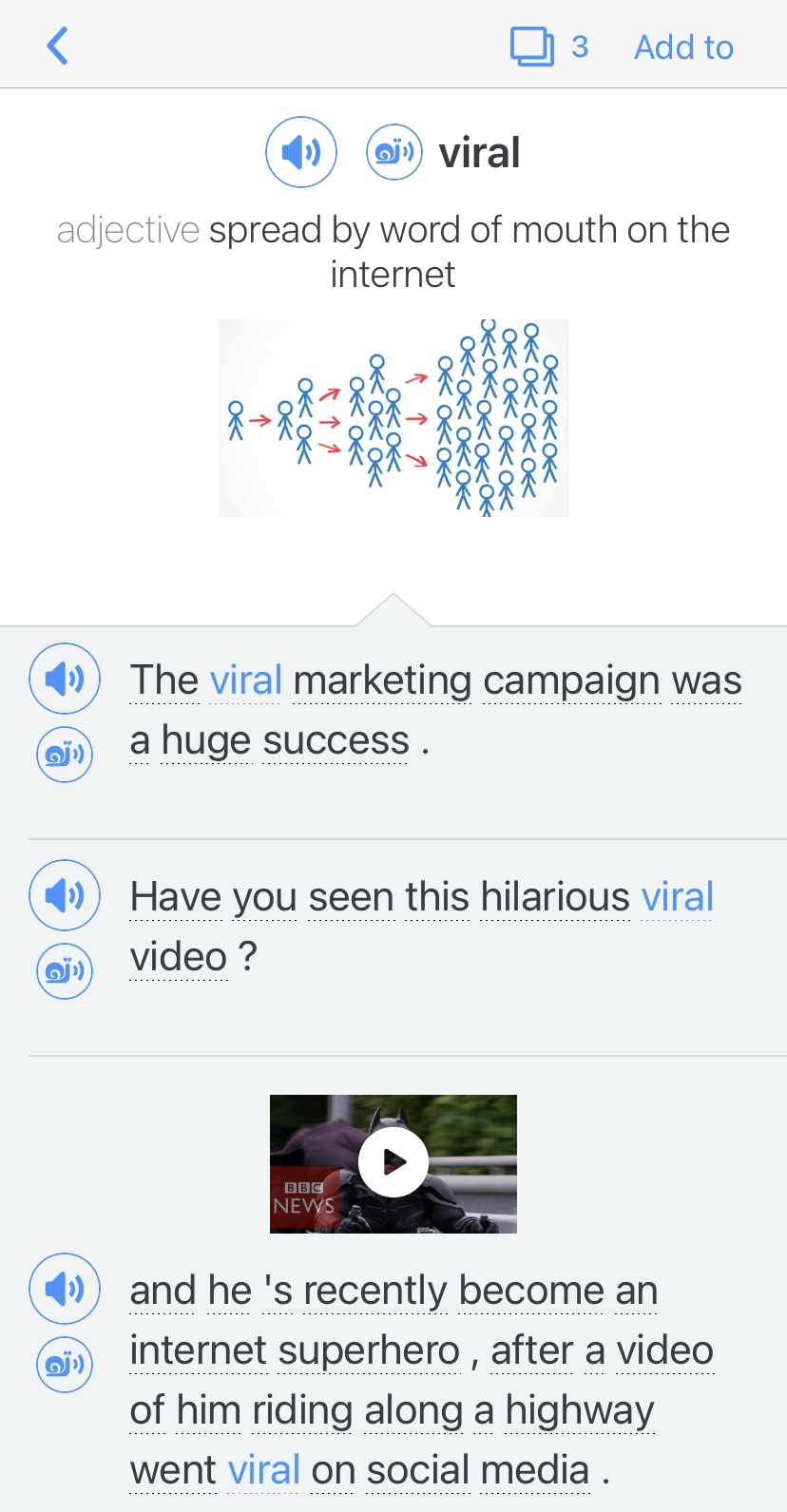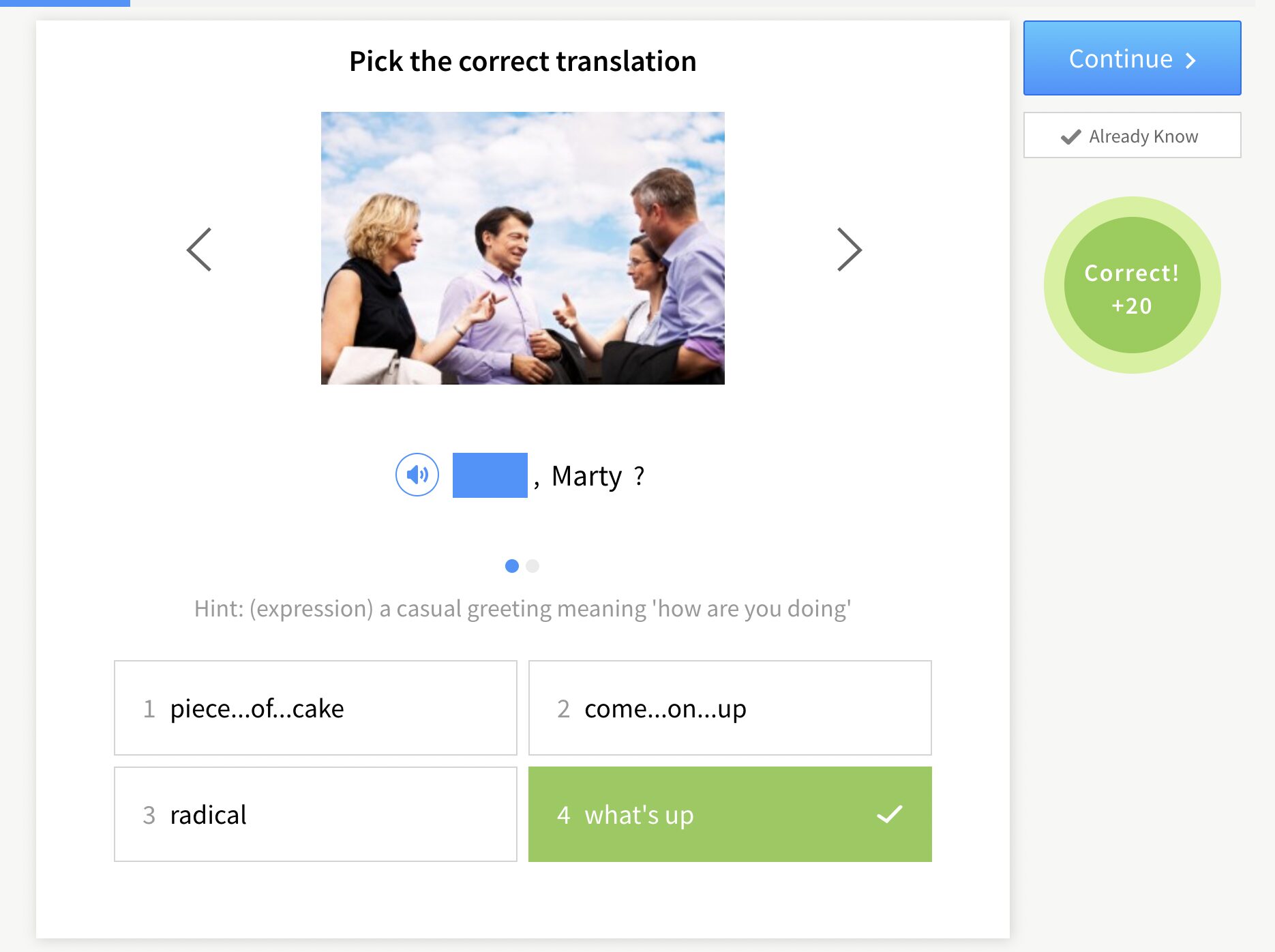Quick English Learning In 6 Steps
The more you study and expose yourself to the English language, the better you’ll become—but you don’t have to spend hours a day studying to improve your language skills. You can squeeze in some learning, even when you don’t have much time in your busy schedule.
Use this short but effective study routine below to improve your English skills even if you don’t have much time.
1. Learn a New Vocabulary Word
Even if you don’t understand all the words you read or hear, a lot of times you can understand the basic idea of what they mean with basic english speaking skills.
Instead of using context clues (the words around a vocabulary word in a sentence), take just 7 minutes a day to really learn one word well.
Where can you find words to learn? You can check out the Word of the Day in Britannica Dictionary, which has useful words for English learners with simple definitions written so that learners can understand them.
Or you can visit this website. Or this one. Yes, that’s right—you can learn vocabulary from an entertainment website or a fashion magazine!
You can also use the language learning program to find new vocabulary words to learn. This will super charge your english language skills.
Vocabulary Word Exercise:
- Get a blank piece of paper (or an index card).
- Choose a vocabulary word to learn.
- Divide the paper into four parts.
- Write the vocabulary word in the center.
- In the top left, write the definition and the part of speech (e.g. noun, adjective, verb, etc.) of the english words.
- In the top right, write a sentence using the word.
- In the bottom left, write synonyms for the word. Synonyms are different words that mean the same thing.
- In the bottom right, write the different forms of the word. For example, for “swim” you would also write “swims,” “swimming,” “swam” and “swum.” Try to understand when you would use each form.
Now use your new word during the day!
2. Learn a New Phrase From Native Speakers
Phrases are just as important as individual words if you want to speak English confidently. If you only learn the meanings of single words, you might be able to say “How are you?” but you won’t know the phrase “What’s up?”
It’s not always obvious when something is a phrase and not just a regular sentence out of a native english speaker(s) mouth. One way to tell is if you hear the same words repeated in the same order more than once. You can also search for the phrase in the Free Dictionary’s idioms section.
Another way is to look them up on websites like English Daily, which has a huge list of English idioms. Not all the idioms you find on websites like English Daily are actually used in everyday English conversations though, so you’ll need to learn how and when they’re used as well.
You can also check PhraseMix, which has many lessons about more common English phrases available for free.
And of course, immersing yourself in native English media will expose you to tons of English phrases and improve your listening skills. I highly recommend this video from the FluentU English YouTube channel if you want to start learning with TV shows:
Phrase Learning Exercise:
- Choose a phrase from any of the sources above.
- Read the phrase and the sentence that the phrase is in.
- Answer these questions: Does your native language use a similar phrase? When might you use the phrase?
- Come up with your own sentence using the idiom in a way that you would in your everyday life.
3. Strengthen Your English Language Grammar Skills
Can you name all the word forms and tenses in a sentence in your own native language? You probably can’t!
As a language learner, though, it’s important to understand grammar rules. That way when you practice speaking english, its with correct english grammar and sentence structure.
Learn a little at a time! Choose one grammar rule to learn each day. You might be surprised at how much better you remember things when you learn them one at a time.
There are plenty of websites that give very short and clear explanations of single grammar rules. One good source is 5 Minute English.
Another great website is the British Council’s English Grammar Reference. You can test yourself here with interactive quizzes for each grammar rule.
Grammar Building Exercise:
- Read a short grammar lesson from any of the websites mentioned above (or your own source!).
- Visit any website you love that has at least a little writing. For this example, you can find an article in Elle.
Look for examples of the grammar rule being used on the website. For example, if you’re learning about conditionals, you can search the page for the word “if” (just press Ctrl+F and enter the words you’re looking for).
4. Read the News Written By Native English Speakers
Reading the news in English not only helps you learn the language. It also gives you something current to talk about when you meet with others who are speaking English. Thus, it makes the learning process fun.
There are many websites with news articles written for English language learners. Voice of America has articles that are easy enough to understand but still have some challenging words and sentences. Breaking News English and News In Levels have different levels of news that you can choose based on your English skill level.
You can also visit any English news website like Yahoo News or ABC News, but articles on these websites can be harder to understand.
If you love technology, you might enjoy TechCrunch. If you prefer music news, maybe MTV is the better website for you.
Check out this video to find more tips and resources for learning English with the News:
News Reading (and Speaking) Exercise:
- Find a news article that interests you.
- Scan the article for words you don’t know and find their definition. That means you should look through the article without actually reading every word.
- Read the article.
- Did you understand at least the basic idea of the article? Explain out loud what the article was about as if you’re talking to someone about it.
5. Review What You Learned
Take five minutes to review (go over) the things you studied. How much do you actually remember from what you learned?
Review Exercise:
- When you do this exercise, do everything out loud to practice speaking. Write everything down on paper to practice writing. You can also quietly review it all in your head.
- Use your new vocabulary word in a sentence.
- Use your new phrase in a sentence.
- Use the grammar rule you learned in a sentence.
- Summarize the article you read in a sentence or two.
6. Use Different Resources to Practice English
- Language exchange apps. Tandem and HelloTalk are popular choices for language exchange apps. They let new language speakers connect with native speakers online. This makes learning a new language easy. You can make video or audio calls, send text messages, post on your feed and more. Your language partners help you learn English and in exchange, you help them learn your native language. You can read our in-depth HelloTalk review here and our Tandem review here.
- Use free daily learning apps. For example, the Learn English Daily app teaches you everyday vocabulary. It includes lessons like “100 Common Conversations,” “Essential Phrases,” “Essential Words” and more. It includes pronunciation guides, basic grammar and even advanced lessons. “Word of the Day” apps are also incredibly useful—they teach you one new word every day.
- Conversation videos on YouTube. YouTube has hundreds of hours worth of English conversations geared towards learners. For example, the Daily English Conversation channel has over 300 videos of English conversations and listening practice videos.
If you feel like you don’t have enough time to learn English daily, now you do! All it takes is about 35 minutes per day and you’ll discover how fun and easy learning English can really be.
And One More Thing…
If you’re like me and prefer learning English on your own time, from the comfort of your smart device, I’ve got something you’ll love.
With FluentU’s Chrome Extension, you can turn any YouTube or Netflix video with subtitles into an interactive language lesson. That means you can learn from real-world content, just as native English speakers actually speak.
You can even import your favorite YouTube videos into your FluentU account. If you’re not sure where to start, check out our curated library of videos that are handpicked for beginners and intermediate learners, as you can see here:
FluentU brings native English videos within reach. With interactive captions, you can hover over any word to see an image, definition, and pronunciation.
Just click on the word to see other example sentences and videos where the word is used in different contexts. Plus, you can add it to your flashcards! For example, if I tap on the word "viral," this is what pops up:
Want to make sure you really remember what you've learned? We’ve got you covered. Practice and reinforce the vocab from each video with learn mode. Swipe to see more examples of the word you’re learning, and play mini-games with our dynamic flashcards.
The best part? FluentU tracks everything you’re learning and uses that to create a personalized experience just for you. You’ll get extra practice with tricky words and even be reminded when it’s time to review—so nothing slips through the cracks.
Start using the FluentU website on your computer or tablet or, better yet, download our from the App Store or Google Play.
Click here to take advantage of our current sale! (Expires at the end of this month.)







